The Complete Framework for Creating Effective Marketing Objectives
This year, we reached over 20 million in-market shoppers. Our campaigns delivered a 400% return on ad spend. We beat industry benchmarks and surpassed our goals – we’re crushing it! Then why is revenue down year over year?
Sound familiar?
The truth is, without proper alignment between marketing objectives and business goals, campaigns often fall short of expectations. You might be unsurprised to learn that nearly 70% of advertising campaigns fail to deliver measurable business impact.
The challenge isn’t just about setting marketing goals – it’s about setting the right ones. Where the advertising industry has relied on an excess of data points (likes, clicks, conversions), less attention has been paid to the metrics that actually keep a business running.
So, what makes an effective marketing goal? Instead of diving into channel-specific metrics or campaign objectives, let’s start where it really matters – the business itself.
Business Goals: The Basis of Marketing Success
When it comes to running a business, the basis of operation is ‘cash in, cash out’. The product can be spectacular, the marketing materials detailed, but without customers buying the product, none of it works.
Sales
Sales are a key measure of business growth and potential as they track the number of customers that purchased the product. Along with average order value, they determine how much revenue a business has generated.
Revenue
Revenue is the top line business metric that determines whether a business is growing or not. Without growth in revenue, there’s less reason to spend money on marketing.
The reason? In order to spend money, you have to first make money. This isn’t a novel concept, but one that’s often overlooked in marketing plans. More specifically, how will these efforts drive incremental revenue?
Profit
The key metric determining the success of a business. Rather than just looking at revenue and sales, how much money is left after all factors – cost of goods, marketing investment, salaries – are weighed in.
Top line growth in revenue may be overshadowed by the fact that more money was spent on acquiring those sales. If this is the case, then the business still fails.
Without an obsession for business ROI, marketing goals will be doomed to fail. So, how can you apply these to marketing efforts.
Essential Marketing Metrics
The key to setting effective marketing goals is an emphasis on their business impact. Let’s take a look at how this can be done through two metrics key to business success.
New Customer Acquisition Cost (nCAC)
Where sales are a measure of all customers, nCAC is a measure of sales from customers that haven’t purchased before. To calculate customer acquisition cost:
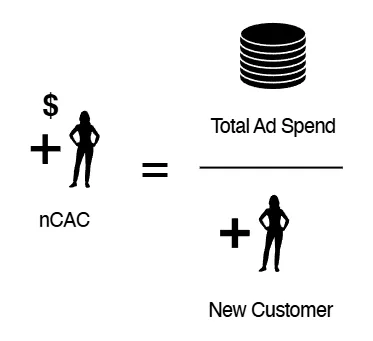
The why: New customers are vital to a businesses growth potential. Without them, it’s almost guaranteed that revenue will stay stagnant unless efforts are taken to upsell existing customers.
Customer Lifetime Value (LTV)
Once a customer is acquired, it’s possible for them to become repeat purchasers, especially if they like the product. As customers become repeat customers, the lifetime value of that individual grows.
This calculation is based on averages so you can project the future potential value of a customer.

With rising ad costs, customer acquisition cost can actually outweigh the initial return on investment, but lifetime value can make up for this in the future. Let’s look at an example:
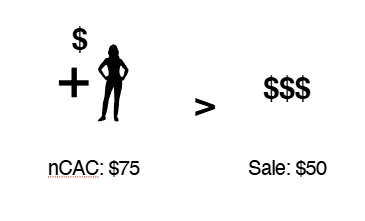
Initially, the ROI is negative and would not be sustainable. However, this product comes with a $50/year subscription.
Yearly Recurring Revenue (subscription or repeat purchase) = $50
Average Customer Lifetime = 3 Years

Over this customer’s lifetime, the business has a positive ROI. Just remember, to get here required an initial loss so this wouldn’t work for a startup/small business reliant on short term cash flow.
Media Efficiency Ratio (MER)
Where nCAC and LTV work to identify how much to spend on acquisition efforts, media efficiency ratio (MER) looks at all marketing activity in aggregate.
In doing so, channels that are more discovery-focused (top of funnel) like Youtube, Facebook, TikTok get balanced out by conversion-focused (bottom of funnel) channels like Paid Search, Organic Search, Email.
To calculate MER:
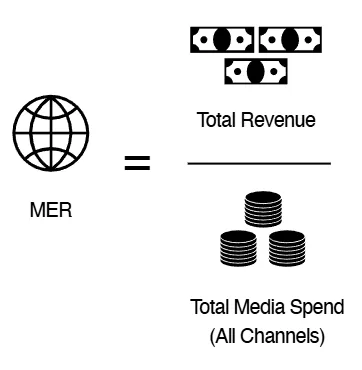
To make this formula even more powerful, consider the following:
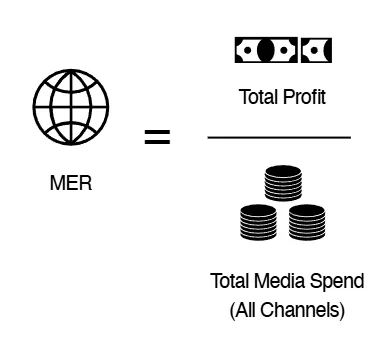
By looking only at profit, you remove the cost of making the product (CoGS) and effectively gain a more realistic view of the overall business health.
If MER is below a 1.0, you’re effectively losing money. So you know metrics, but how do you strategically plan for them?
Setting Marketing Goals: A Framework for Success
Creating a profitable marketing campaign takes creativity, strategic thinking, but most importantly, great measurement protocols.
After all, your campaigns are only as effective as your ability to measure the results. This means creating projections.
Creating Projections
Setting marketing goals requires some measurable result. This has historically been bottom line metrics like revenue or sales, but in today’s digital era much more is available to measure.
While this is great in some sense, it also serves to distract from the main point of marketing – to sell more. Clicks are not worth anything if in the end they don’t drive a sale.
Back to the business basics
To plan for success, it’s best to start with what you’re able to pay to acquire a new customer. This involves an intimate understanding of business financials including:
- What it costs to make a product (CoGS)
- How much each product costs
- Miscellaneous fees that factor into selling a product (tax, shipping, etc.)
Once you’ve worked this out, the picture becomes clearer. If you make $50 from a sale (after CoGS & fees), your customer acquisition cost should be less than that, right? Sometimes…
The CAC/LTV Difference
There are two scenarios where your customer acquisition cost can be higher than revenue from the sale:
- High customer lifetime value
Customer acquisition cost is only paid once during the customer lifetime which is why retention is so important – the longer you keep a customer, the more revenue they can generate.
Going back to our previous example:
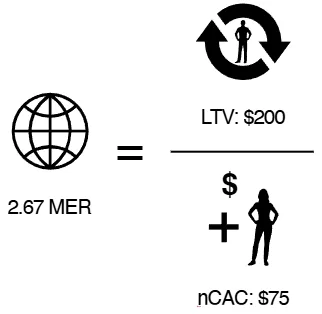
Let’s imagine that the customer was actually retained for 5 years instead of 3.
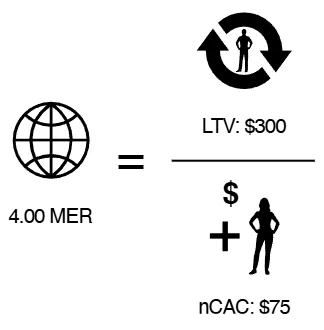
Not bad, but we can do better.
- Strong organic presence
When it comes to customer acquisition, not all channels are the same. Traffic acquired through organic search, word of mouth, PR, etc. are often much more cost effective than paid media.
This has the benefit of significantly decreasing customer acquisition cost – the drawback however is the time and effort required to gain attention this way.
This is great in practice but how does it apply to marketing campaigns?
Sales vs Lead Generation Goals
When it comes to measuring digital marketing, the goal of a campaign can vary widely. For a refresher, see Meta Ads Optimization Goals.
For the purpose of this discussion, we’ll focus on conversions, but just know that awareness and engagement goals should still consider impact on the bottom line.
Conversion goals are broken down into two categories: Sales and Leads.
Sales
When direct product sales are measured, projections are straightforward. The key metrics as discussed are customer acquisition cost and customer lifetime value.
This can be driven by ad clicks or website visits from organic traffic, but regardless the primary metric of success is conversion rate.
Conversion rate determines how much traffic (clicks or visits) are needed to drive a purchase (sale). Conversion rate varies based on several factors including (but not limited to):
- Price of product
- Value to consumer
- Website or user experience
- Brand reputation
Benchmark conversion rates depend on these factors, but typically will range from 1% – 10%. This is only half the equation though, traffic also impacts sales.
Clicks or website visits are key in projecting success as they represent the first step a potential customer takes towards buying your product.
In the paid media world, cost per click is the key measure of potential as it communicates efficiency, and allows you to measure against customer acquisition cost. Consider the following example:
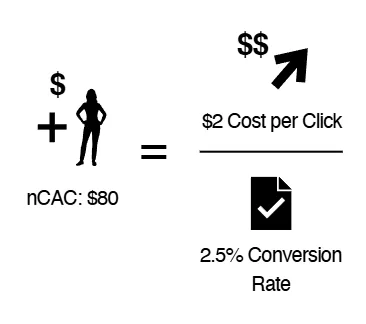
A click will turn into a purchase 2.5% of the time, meaning a $2 click will ultimately lead to a $80 customer acquisition cost.
Hopefully this is a new customer, otherwise you could end up paying $80 for someone that might have converted anyway.
Pretty simple, right? Let’s look at something a bit more complicated.
Leads
Leads follow a similar path – clicks > conversion rate > lead. However in this case, there is no attributed revenue for a lead.
First, the lead must be converted to a sale. But, not all leads will convert to sales. This adds another consideration:
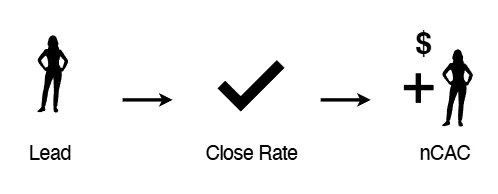
Close rate will be based on a number of factors including but not limited to:
- Quality of lead
- Effectiveness of sales team
- Competition in market
- Deal size
Lead quality is a primary factor in marketing performance due to its direct control over who is reached and how they are engaged.
Things like robust lead forms, multi-step forms, and CAPTCHA can help improve the quality of leads, but ultimately some leads will always be worth more than others.
Factoring this into projections is necessary instead of treating all leads equal. The equation will look like:
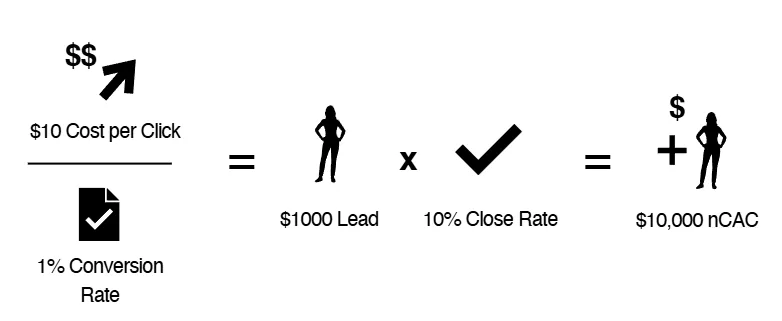
Similar to sales, factoring in customer lifetime value is absolutely essential. A $20,000 customer acquistion cost is high, but could be offset in the long run with recurring revenue (subscription cost).
Setting Realistic Marketing Benchmarks
Benchmarking is the practice of using available data to more accurately predict the outcome of a campaign. Benchmarks are pulled from two sources:
- Historical data (if available)
- Industry averages
Using historical data is always recommended as each business is unique so industry averages won’t always very accurate. However, when setting expectations, referencing the industry average can be helpful.
Key metrics that need to be benchmarked are:
- Cost per Click
- Click-Through Rate
- Conversion Rate
Since they are calculated metrics, you will be able to derive absolute numbers from them.
- Cost per click → Clicks
- Click-Through Rate → Impressions → CPM
- Conversion Rate → Conversions → Cost per Conversion
From here, you can start to build expectations for nCAC and LTV, aiming to find that balance between scale and efficiency.
The Bottom Line on Marketing Goals
Setting effective marketing goals isn’t just about tracking likes, clicks or even conversions – it’s about driving measureable business growth. Even with attention paid to marketing KPIs, campaigns can and often fail to deliver real value.
The key to success is aligning business and marketing goals through metrics like customer acquisition cost, customer lifetime value, and media efficiency ratio. And, in everything you, tying actions back to revenue and profitability.
The most successful marketers aren’t just campaign managers – they’re business strategists who understand how their efforts impact the bottom line. By aligning your marketing goals with core business objectives, you’ll be better positioned to deliver results that truly matter.
